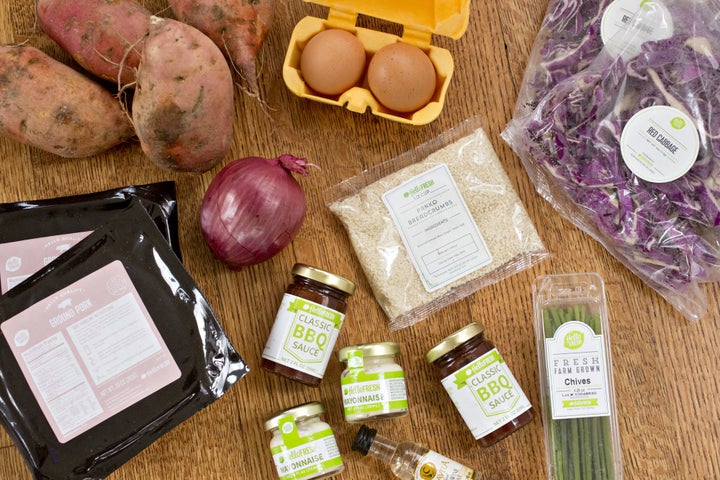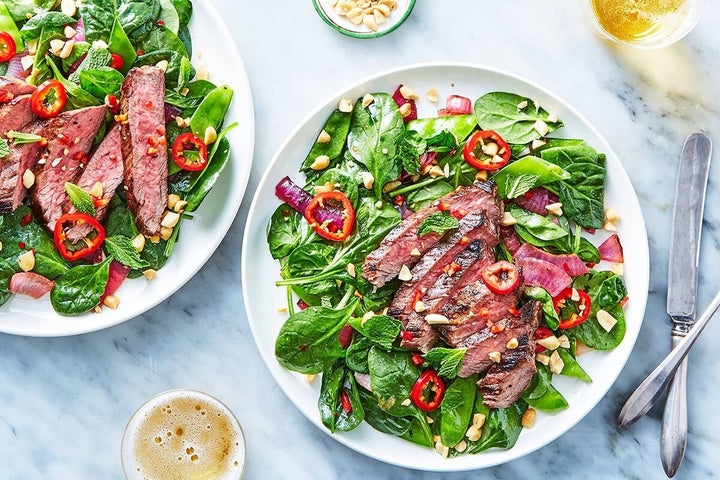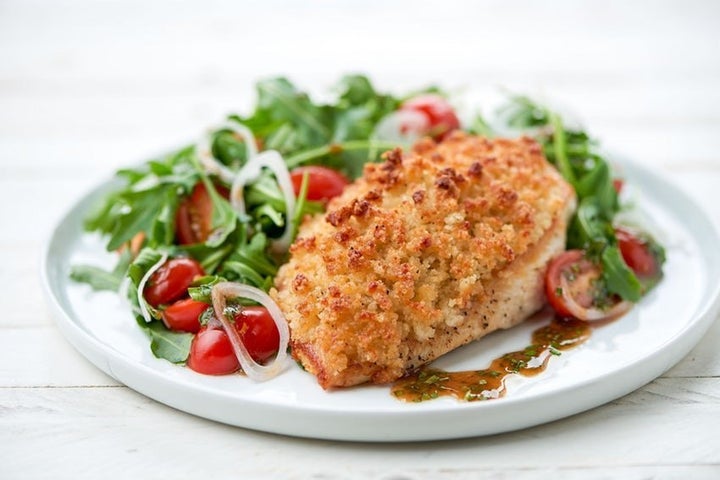
Grocery shopping has always been a struggle.
I’ve planned out my shopping list in advance. I’ve meal prepped. I’ve avoided shopping while hungry. But since our household consists of just me and my boyfriend (and our dog, who, frankly, eats better than we do), it’s hard to gauge how much food we need for the week. We inevitably end up throwing some of it out.
Americans waste about 40% of food produced in the United States, which costs households, businesses and farms about $218 billion each year. I hate knowing that we’re contributing to that statistic. Being in Los Angeles, we just order takeout. That doesn’t do any favors for our wallets or waistlines.
The Mission
Then one day, I was served an ad for a meal kit delivery service on Facebook. The service promised creative meals I could cook in less than an hour, with precise ingredients so nothing would go to waste. In fact, once I clicked on that ad, my feed was inundated with coupons for new customers of every meal kit service under the sun.
I thought, what if I subscribed to a different service every week and used their discount codes?
And so I embarked on a mission to find the best service for weeknight meals that were fast, healthy and wouldn’t go to waste, all while saving money in the process.
1. Blue Apron (Grade: B)

- Plan: Two-person, two recipes per week
- Original cost: $43.96/box, $7.99 shipping
- Discount: $50 off first two boxes
- Average cost per serving (post-discount): $6.74
Blue Apron was the first service I tried when I received an offer for $50 off my first two boxes. That essentially cut the cost of a box in half, so I decided to give it a shot.
Blue Apron offers a few different plans. There’s the two-person plan, which lets you choose either two or three recipes per week. There’s also a family plan, which feeds four and comes with two, three or four recipes per week ― and each of the two-person plans come with “vegetarian” or “wellness” options.
Every plan except the two-person, two-recipe plan offers free shipping. But fearing we wouldn’t squeeze three home-cooked meals into one week, I opted for the 2x2.
Right off the bat, I was intrigued by the recipe options, since they were ingredient and flavor combinations I’d never think to cook on my own. I chose the spicy pork and Korean rice cakes with baby bok choy, as well as the chicken and orange kale salad with spicy tahini dressing.
When it came time to actually cooking the food, things went fairly smoothly. All I needed was salt, pepper, olive oil and basic kitchen utensils. However, though the instructions were easy to follow, the estimated cooking time for both recipes was pretty optimistic. It took more time for me, most likely, because I wasn’t familiar with all the techniques. Both dishes took me about an hour to prepare from start to finish.
I also wasn’t thrilled that the spicy pork rang in at over 750 calories per serving and featured a slew of empty carbs. But damn, it was good. The flavors were bold and the chewy rice cakes provided a surprisingly satisfying texture.
The salad, which was part of Blue Apron’s Whole30 menu, was also remarkably tasty. I even learned how to make kale taste like actual food (marinate it!). At 650 calories, I didn’t feel as guilty about serving this meal, especially because it was made up of mostly protein and veggies.
Final verdict: I thought the recipes were creative and helped me get outside my culinary comfort zone. And though they were delicious, I do wish there were more low-calorie and low-carb options on the menu.
2. HelloFresh (Grade: B-)

- Plan: Two-person, two meals per week
- Original cost: $39.96/box, $7.99 shipping + $10.00 for premium recipe
- Discount: $25
- Average cost per serving (post-discount): $8.24
The next plan I tried was HelloFresh, using a $25 off coupon for my first box. This service offers three plans: Classic, veggie and family. The classic plan feeds two or four people, with the option to receive two, three or four meals per week. The vegetarian plan feeds two or four people, with three recipes per week as the only option. Finally, the family plan feeds four, with either two or three recipes per week. Again, I opted for the two people, two recipes plan.
I’m a sucker for a good steak, so the first meal I made was the hoisin marinated ribeye steak with bok choy, scallion pesto and mashed potatoes. What I didn’t realize, however, was that the “premium” tag on this particular recipe I saw when I selected it meant I’d be billed an extra $10, bringing up the average cost per serving considerably.
I wouldn’t have minded the extra cost, but the quality of the ribeye was poor. I was skeptical of the cooking time, as I prefer steaks medium-rare, so I pulled it off the pan early. Still, the meat was stringy and tough. The sides were decent (bok choy is really growing on me), but at a whopping 1,180 calories per serving, I didn’t feel this meal was worth the indulgence.
The second meal I prepared was the pineapple pork chop with sugar snap peas and jasmine rice. This recipe was much more reasonable at 510 calories. Even so, I felt like I had to make up for the rib eye debacle, so I swapped out the jasmine rice for some riced cauliflower from Trader Joe’s. The cooking time on this one also seemed high, so I pulled the pork out of the oven a few minutes early and let it rest to 145 degrees. If I hadn’t, it definitely would have been overcooked.
Final verdict: HelloFresh offers a bit more variety to accommodate dietary restrictions, such as an entire plan dedicated to meat-free meals. Stacy Gordon, the chief product officer at HelloFresh, told me the company’s recent acquisition of the delivery service Green Chef has allowed them to offer more specialty and allergen-related plans. Personally, the plan I chose didn’t quite meet my needs ― it ended up being more expensive and I would have liked more creative recipes with higher quality proteins.
3. Martha & Marley Spoon (Grade: C)

- Plan: Two-person, two meals per week
- Original cost: $48.00
- Discount: $30 off first box
- Average cost per serving (post-discount): $4.50
Marley Spoon teamed up with Martha Stewart in 2016 to launch Martha & Marley Spoon, which features Stewart’s award-winning recipes and cooking techniques. There is a two-person plan, as well as a plan that feeds three to four. Both plans allow you to choose two, three or four recipes per week.
Hoping some of Martha’s kitchen magic would rub off on me, and scoring a generous $30 off my first box, I decided to give this service a shot next.
My first recipe was the Cajun-spiced chicken with red beans and grits, which was 819 calories per serving. New Orleans is one of my favorite cities, so maybe a longing to be back sipping Sazeracs and listening to jazz led me to choose this one. In the end, however, I didn’t exactly feel like I was dining on Bourbon Street. The meal was tasty enough, but it wasn’t particularly creative.
The second recipe I chose was the Bloody Mary steak salad with caramelized tomatoes, which was 664 calories per serving. I thought my previous experience with steak might have been a fluke, so I decided to give Martha & Marley Spoon’s version a shot. That was a mistake. The steak was a lower-quality cut that ended up tough despite cooking it medium-rare. The rest of the salad consisted of romaine lettuce and warm tomatoes. I wasn’t impressed, though I blame myself for choosing this questionable recipe.
On the positive side, both meals were very easy to prepare and required the most basic ingredients and utensils from my own kitchen. Jennifer Aaronson, the culinary director of Martha & Marley Spoon, told me the company strives “to get the most flavor out of the fewest ingredients (less prep, less cleanup!) in the shortest amount of time.” In that respect, this company delivered on their promise.
Final verdict: Though the food was decent, Martha & Marley Spoon was my least favorite of all the meal kits I tried. The results fell flat compared to my expectations; maybe they were set too high by the prospect of cooking recipes designed by the Queen of the Kitchen herself. However, given the opportunity to try more recipes, I might have found options that were more in line with my needs.
4. Home Chef (Grade: A)

- Plan: Two-person, three recipes per week
- Original cost: $59.70
- Discount: $30 off first box
- Average cost per serving (post-discount): $4.95
When signing up for Home Chef, I was prompted to fill out a “taste profile” and select certain dietary preferences. Unlike other services that simply allow you to exclude foods from your meal options, such as dairy or shellfish, Home Chef goes a step further to craft weekly menus according to more specialized diet requirements. For instance, I selected low-calorie and low-carb as my preferences.
Home Chef offers the most recipe options out of all the services I tried. You can choose between two and six recipes per week, with two, four or six servings per meal. Each serving is priced at $9.95, but there is also an option to add on breakfasts and quick lunches for a small additional charge per meal. Orders under $45 cost $10 for shipping, otherwise it’s free.
I opted for the two-person, three-recipe plan because I was able to use a discount code for $30 off my first box with this option.
The first recipe I made was the pork chop with garlic-butter mushrooms and mashed carrots. At 623 calories, I enjoyed the hearty comfort-food feel without the unnecessary carbs. The mashed carrots provided a fresh alternative to the conventional potato side.
Next up was the parmesan-crusted chicken with arugula and balsamic vinaigrette at 548 calories. I particularly loved this recipe ― the parmesan crust really jazzed up an otherwise boring protein option. The addition of shallots to the arugula salad added another dimension of flavor without the harsh bite you usually get from onions.
Finally, I prepared the Acapulco fajita beef skillet with pico de gallo. This could have been nothing more than fancy hamburger helper. However, the recipe was elevated by ingredients such as fresh poblano pepper and Chihuahua cheese. And at 564 calories per serving, I indulged in my love of tacos without regretting it the next day.
The final verdict: Home Chef was definitely my favorite of all the meal kit services I tried. I was not only impressed with how the meals tasted, but also the diversity of recipes in each week’s menu. “We differentiate ourselves from other meal kit brands by offering more variety and customization to our customers,” Home Chef’s chief revenue officer, Rich DeNardis, told me in an email. And I agree. I never felt like I had to compromise on health in order to receive a satisfying meal.
Are Meal Kits Worth It?
In the end, these meal kits did save me money. After my first month of subscribing to meal kits, my grocery spending dropped by about $300 without increasing my total food budget:

Granted, there were fewer days in February. I also relied on heavily discounted boxes for first-time customers. If I had subscribed to regularly priced meal kits, the savings would have been smaller.
There are ways to earn additional discounts, such as getting new customers to join using a personal link. A couple of services even sent me more coupons in the mail after I canceled my plans. However, I don’t think all that hustling for additional discounts would be worth the effort. I liked Home Chef enough to continue the plan at full price ― and I plan to.
The truth is, if you spend the time to strategically plan out your recipes for the week, shop for low-cost ingredients and cook meals in larger quantities, you’ll probably save more money than you will relying on a meal kit. But the savvy cook is not the intended customer of these services.
Another downside to meal kits: Although these services address the problem of food waste, they create a great deal of packaging waste. Sure, the box itself and insulation are recyclable, but those plastic containers and tiny jars of mayo aren’t. Plus, those special weekly deliveries contribute to a larger carbon footprint.
Clearly, meal kits are about convenience. And as a single, busy professional, that’s exactly what I need. Despite a small savings up front, my hope is that a healthier diet and less food waste today will pay off in the long run.
NOTE: Prices were correct at time of publication, and are subject to change.
